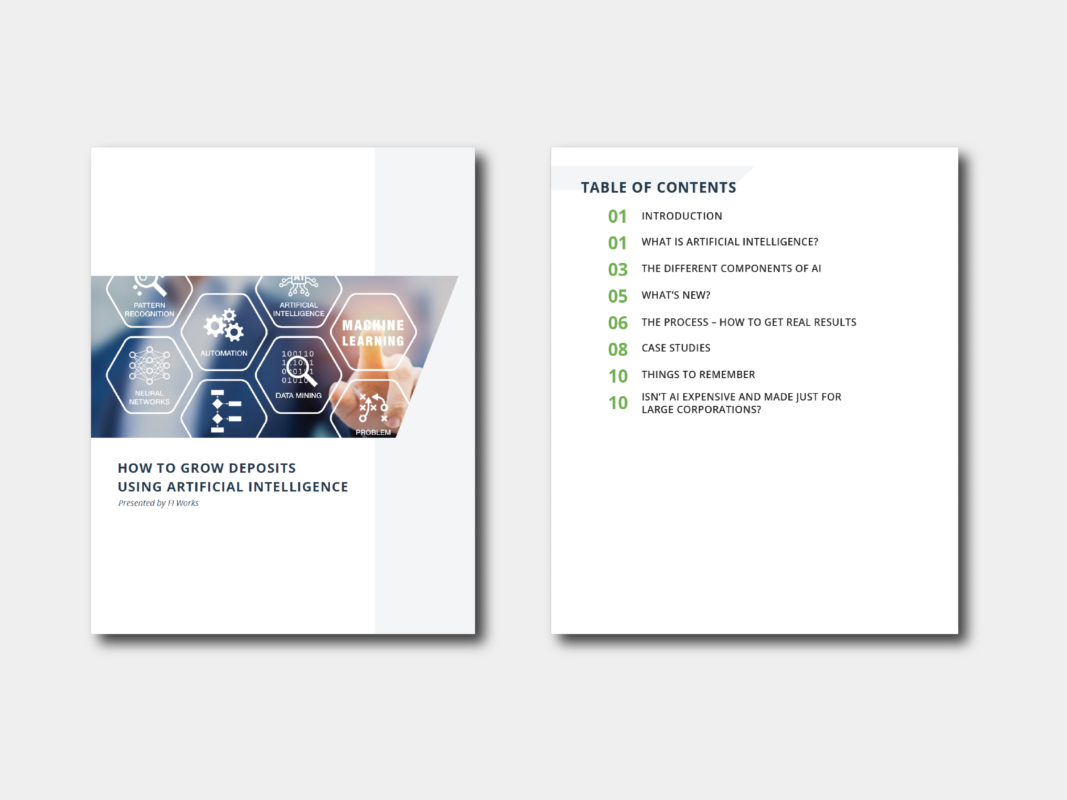To many, Artificial Intelligence (AI) seems complex and unattainable. What is it really, and why should community banks take it seriously? How can smaller institutions overcome the many hurdles and objections to AI?
What is AI?
While there’s no solid consensus on the definition of AI, the phrase is mostly used to describe the multiple ways that computers learn from patterns of data by mimicking the way humans think. The human mind can only understand data in a maximum of 2 to 3 dimensions, but AI can consider thousands of data elements at a time.
AI processes data in order to find patterns or make predictions. Using its most broad definition, financial institutions have been working with AI for many years through services like FICO credit scores and fraud alerts. Everyone understands how FICO scoring works, but behind the scenes it’s applying AI to create each score. FICO boils down tons of complex financial behaviors into a single predictive score. This is an example of how the financial industry uses the results from AI on a daily basis. Likely, your institution didn’t have to “implement” AI to adopt the FICO. Using AI elsewhere works the same way.
Every day, our phones, cars, browsers, and streaming platforms make recommendations catered to us – this is AI at work! From things like Apple’s Siri to what you see on your Facebook feed, it’s clear that AI is becoming more of a constant in our lives.
The “AI” term is often used in vague ways with little explanation of how it actually solves business problems. Because it is complicated, people look at AI as an insurmountable barrier. We want to assure you that AI is not as ambiguous or scary as it seems. It is hard to understand sometimes, but there are still ways community financial institutions can leverage it without spending millions of dollars or knowing everything about it.
Bankers know that AI is the future, but its many complexities have kept them stagnant because they don’t know where to start. It’s time to take the idea of using AI seriously and accept that it doesn’t have to be complicated for smaller banks or credit unions to utilize it. Let’s look at some of the ways that AI benefits financial institutions, frequent concerns we hear, and ways to overcome objections.
Get serious and get started: How can community banks take advantage of AI today?
Here are some of the ways financial institutions benefit from AI. Right now you may only be utilizing a few, but even community-sized institutions can take advantage of each of these with the right partners and tools:
- Understanding customer needs with cross-sell models
- Finding leads that look like your best customers
- Predicting attrition of checking accounts
- Lowering credit risk with credit scoring
- Reducing fraud through fraud detection
- Enhancing cyber-security
- Lowering customer service costs with chatbots
- Automating routine processes with Robotic Process Automation (RPA)
- Natural language processing to scan and process documents
AI Objections
We recognize that there seem to be mountain-sized hurdles in the way of getting started. Do not let these hurdles hold you back. It’s time to get serious about how AI will benefit your financial institution and overcome your objections. We hear these objections all the time:
“We don’t have quality data.” Banks have lots of customer data – more than any other industry. Yet, silos and other legacy technology keep you from seeing and using it and causes a “data dilemma”.
Solving your data dilemma for AI is a lot like renovating a house – You don’t set out to renovate every room at once. You pick the most important room (your most important business problem) first, before starting on the next. Tackling one problem at a time makes everything less complicated and better prepares you to tackle future problems. Solve your data dilemma first and the rest will follow.
“It costs too much.” Big banks spend millions on large-scale AI projects with software, hardware, and labor.This may seem unrealistic to a smaller institution with a smaller budget and team.
Luckily, you have other options. Partnering with fintech companies helps lower costs for your institution. We know that enterprise software can be much too expensive for a community financial institution–so let the fintech companies do this for you! With so many options in the market, you are sure to find a solution that fits your size and budget. AI-enabled applications can even pay for itself after just a few marketing campaigns.
The aggregate potential cost savings for banks from AI-based applications is estimated at $447 billion by 2023, with the front and middle office representing $416 billion of that figure. (Business Insider Intelligence)
“We don’t have/can’t afford a data scientist.” Data scientists are in high demand and have starting salaries of around $100K.Good news – you don’t need one! You do not have to be an expert or build everything in-house. Huge banks can spend tons sourcing that talent, but community-sized institutions should be able to have that resource without having to hire. Your technology vendors need to have a data scientist, not you!
“It’s too complicated.” If you build it yourself, it will be complicated. But it doesn’t have to be! Think back to the FICO example: For decades, the financial industry has trusted the FICO score to measure consumer credit risk. FICO takes something really complicated and turns it into something simple and easy to use. You need to look for vendors who will do this for you in other problem areas as well.
“This is the way we have always done it.” That is the most dangerous phrase in business. Customers and the industry have changed (and will continue to change), and change is a good thing. Let’s face it–intuition-based marketing won’t cut it anymore! The old tried-and-true ways don’t always work when your competitors are using data to market to your customers.
“This is the way we have always done it” is the most dangerous phrase in business.
Overcoming Obstacles
Target the business problem, not the technology. Adopt a solution to solve the problem you have. If you have a cross-sell problem, focus on a solution that solves that problem instead of getting AI for the sake of having it. The wrong question to ask is, “Should I implement AI?” and the right question is, “What are my biggest business problems?” and “which technology solutions leverage AI to solve them?”
Take it one step at a time. Remember the house renovation example. You don’t have to overhaul your entire house in one day. Think about your big business problems first, then how you can use AI to solve them.
Think of AI as part of an application, not an application unto itself–Creating an AI solution in-house or buying it will be expensive. You don’t have to do it this way! It’s much easier to find a technology with AI baked into it than building it all on your own.
Remember you don’t have to do it all by yourself. Find a partner that works in and knows their way around the financial industry, data, and regulation. When seriously committing to AI in your institution, make sure to commit to a partner that will guide you through the intricacies of the AI world.
What’s an example of AI embedded in an application?
Since we are experts in bank sales and marketing, it only makes sense that we have a sales and marketing example. FI Works uses AI to help financial institutions target customers with the highest propensity to buy or accept an offer. Here’s a step-by-step guide for using AI to solve a cross-sell problem.
Step 1: Determine your business problem – In this case, you want to know which products and services your customers need from you. This helps you meet your customer’s needs with less effort and expense.
Step 2: Data integration– To understand what your customers need, your data must be cleaned and integrated across your silos and reformatted for AI to use. This provides a complete view of your customers and a foundation for AI to do what it is best at.
Step 3: Data analytics – You have to understand your data to know the details of the business problem. This helps you be more precise in asking the right questions. Using AI is not a substitute for understanding your data. AI can give you an answer to your question, but you need the context of the answer that data can provide and, you still need to understand how AI reached its conclusion.
Step 4: Intelligent targeting – AI can identify customers’ needs. It can go beyond basic age and income segments – it creates predictions from multiple data elements. Targeting results in scores for different products and services based so you’re always cross selling based on real customer needs.
Step 5: Utilize your findings with a campaign – You have scores, now what? Take these scores of customers that AI has discovered, and decide the best method of reaching them (call, email, mailer, etc.) Get your findings in front of bankers so they can reach out to customers to grow their relationships. Knowing what your customers actually want makes cross selling much easier, and customers appreciate your knowledge of their needs. Campaigns powered by AI turn valuable data insights into action.
Step 6: Measure everything – You need to know what is (or is not) working. Measuring and tracking everything gives your institution an idea of the successes or failures and lets you know what is worth repeating. Did AI answer your question? Did AI help provide a solution to your problem?
As you can see, if you break the problem down into more digestible pieces, getting serious about AI is easy. With the right mindset, it doesn’t have to be complicated for smaller banks and credit unions to take advantage of such a powerful tool.
Ready to get started with AI?
Request a demo – we’ll show you the ropes!
Like this post? Don’t forget to share!



